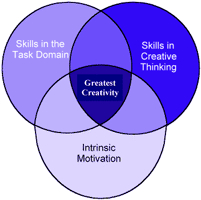 In her classic Harvard Business Review article, How to Kill Creativity, Teresa Amabile argues that the three components of creativity are: expertise, creative-thinking skills, and motivation. At the overlap of each, we find our greatest creativity. Expertise refers to our knowledge and skills related to our task domain (i.e. winning, building, sending or evangelism and discipleship, or movement building, etc.) Creative-thinking skills embrace the flexibility and imagination that we bring to the problems and challenges of our task or work. Intrinsic motivation refers to our inner passion to solve the problem at hand. Such inner motivations, Amabile argues, lead to far more creative solutions than do external rewards.
In her classic Harvard Business Review article, How to Kill Creativity, Teresa Amabile argues that the three components of creativity are: expertise, creative-thinking skills, and motivation. At the overlap of each, we find our greatest creativity. Expertise refers to our knowledge and skills related to our task domain (i.e. winning, building, sending or evangelism and discipleship, or movement building, etc.) Creative-thinking skills embrace the flexibility and imagination that we bring to the problems and challenges of our task or work. Intrinsic motivation refers to our inner passion to solve the problem at hand. Such inner motivations, Amabile argues, lead to far more creative solutions than do external rewards.
In light of these three components, Amabile suggests that organizational inventiveness dies by accident–as an unintended consequence of decisions and designs that seemed perfectly sensible at the time they were made.
Amabile makes several suggestion on how to avoid such accidents. Her ideas might help us protect the creativity and innovation necessary for movement building in our areas of calling (campus, military base, young professionals, high school students, etc.). As the leaders of movements, we can’t afford to kill creativity. We can instead manage creativity by applying the lessons from her six general categories.
1. Challenge: Of all the things we can do as leaders to stimulate creativity, the most effective comes from matching our people to jobs which play to their expertise and to their skills in creative thinking AND which also ignite intrinsic motivations. A perfect match stretches, but doesn’t bore or break, the person’s abilities.
2. Freedom: Creativity thrives when leaders let people decide how to climb a mountain. The key to creativity is giving members autonomy concerning the means–that is, concerning process–but not necessarily the ends. They needn’t, for example, let team members choose which mountain to climb. In fact, strategic goals–the ends–often enhance a person’s creativity. Changing the goals or the ends too frequently or failing to define them clearly creates frustration as does the tendency to proscribe the process to achieving those ends. When our team members possess the autonomy of means, it both heightens intrinsic motivations and creates a greater sense of ownership.
3. Resources: As leaders we must give our teams the two main resources that affect creativity: time and money. Creativity takes times and it can be slow going to explore new concepts, put together unique solutions, and wander thru the maze of solutions. The importance of the work often drives us, however, to a time crunch and make us feel like we have to rush. Now great challenges — i.e. building spiritual movements everywhere — actually increase intrinsic motivation, but when accompanied by fake deadlines or impossibly tight ones, they create distrust and cause burnout. In such cases, our people feel over-controlled and unfulfilled–both of which kills motivation. Leaders must match the right people to the tasks and allocate the right resources (time and money and space).
4. Work-Group Features: Leaders need to carefully design mutually supportive teams comprised of people with diverse perspectives and backgrounds. Such diversity is only a starting point. Each of the team members must share excitement over the team’s goal; he or she must display a willingness to help their teammates thru difficult periods and setbacks, and finally; each member must recognize the unique knowledge and perspective that other members bring to the table. Amabile warns leaders against building homogeneous teams–such teams do little to enhance expertise and creative thinking.
5. Supervisory Encouragement: Leaders must take time to both praise creative successes and unsuccessful efforts. To sustain passion, most people need to feel that their work matters to the organization or to some important group of people. Leaders who enhance creativity recognize this and freely and generously figure out ways to praise good work–whether it has an ultimate impact on the organization or not. Negativity in the leader–time-consuming layers of evaluation of new ideas or harsh critiques of those ideas–kills the creative spirit in people and creates a culture of evaluation and thus fear. Creativity dies and people default to extrinsic motivators and lose all ownership.
(Research shows that leaders will appear smarter to their bosses (and their people) if they are more critical. Sadly, in many organizations, such assumptions often lead to individual advancement—but not in the end to more innovative organizations.)
6. Organizational Support: While the encouragement of leaders certainly fosters creativity, people also want the support of the organization as a whole. Organizational leaders must thus ensure that the appropriate systems, procedures and values are in place to support creative efforts. People need to know that creativity is a top priority at the top of the organization. Organizational leaders demonstrate these priorities when they mandate information sharing and collaboration while ensuring that political problems don’t fester.
Information sharing and collaboration supports all three components of creativity. As people exchange ideas and data by working together, they increase their expertise. When exposed to various approaches to problem solving in collaborative environments, each person’s creative thinking skills are improved. For most people, the pursuit of creative solutions in a company of friends provides enough intrinsic motivations to keep people engaged and ignited.

Leave a Reply